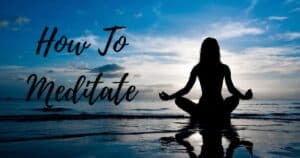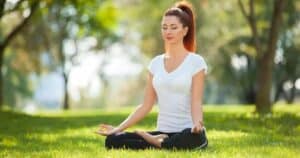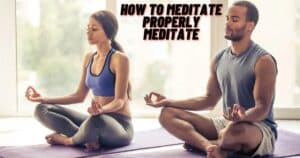Meditation cushion is a padded support designed for comfort during meditation promoting proper posture and spinal alignment. It helps individuals maintain focus and reduce discomfort while sitting for extended periods of meditation practice.
Find the tranquility of meditation by mastering the art of sitting on a meditation cushion. How To Sit On A Meditation Cushion? Begin by selecting a serene space and laying the cushion on a level surface. Once seated comfortably with your legs crossed ensure your spine is straight for optimal relaxation. Let your hands rest on your knees or in your lap palms facing either up or down. As you close your eyes the meditation cushion to become your portal to inner peace.
To sit on a meditation cushion first find a quiet spot. Place the cushion on a flat surface. Sit with your legs crossed comfortably keeping your spine straight. Rest your hands on your knees or in your lap palms up or down. Close your eyes breathe deeply and enjoy the peaceful experience of meditation on your cushion.
Different Ways to Use a Meditation Pillow
A meditation pillow is a versatile tool that can be used in various ways to enhance your meditation practice. Firstly, you can place the pillow under your hips or buttocks to elevate your sitting position promoting a more comfortable and aligned posture. This helps reduce strain on your lower back and allows you to sit for longer periods without discomfort.
You can use the meditation pillow as a support for your knees during seated meditation. By placing the pillow between your knees it provides stability and helps ease any tension in the hips and thighs, enhancing the meditation experience. Explore additional techniques such as Meditation Mantras to further deepen your practice and promote a more relaxed and focused state of mind.
Whether you’re a beginner or an experienced meditator experimenting with different ways to use your meditation pillow can contribute to a more enjoyable and effective practice.
Kneeling with Support
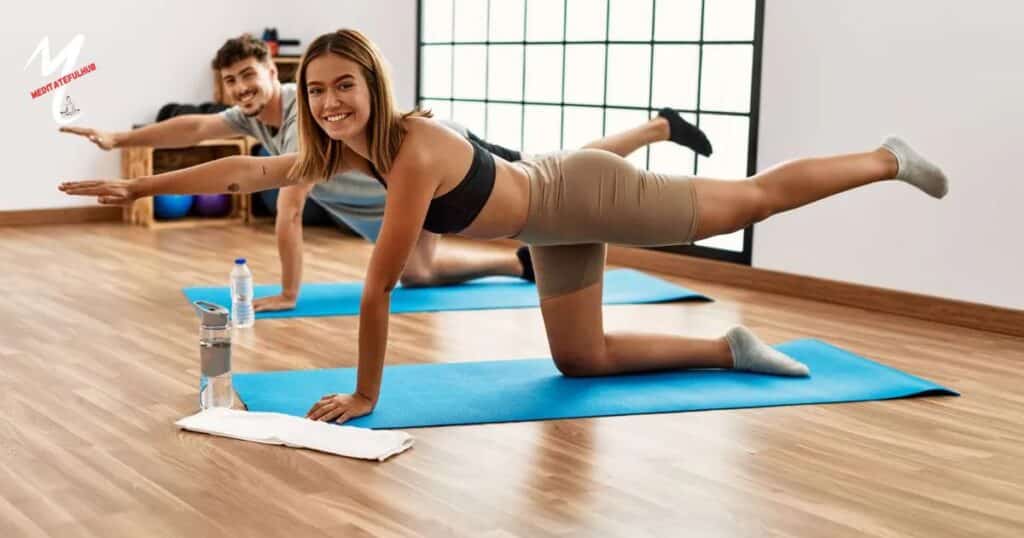
For a unique meditation experience try kneeling with the support of a meditation pillow. Place the pillow between your legs and sit back on your heels allowing the cushion to provide comfort and reduce strain on your knees and ankles.
This posture known as seiza in Japanese meditation traditions promotes a straight spine and encourages a grounded yet alert state of mind. The meditation pillow offers essential support making it easier to maintain this kneeling position for an extended period enhancing your focus and deepening your meditation practice.
Simple Cross legged Pose

Using a meditation pillow in a simple cross legged pose can make your meditation practice more comfortable. Sit on the pillow with your legs crossed allowing your knees to drop naturally towards the floor. This helps create a stable and relaxed foundation for your meditation.
The pillow lifts your hips slightly reducing strain on your back and making it easier to maintain an upright posture. This simple adjustment can enhance your meditation experience by providing comfort and support allowing you to focus on your breath and inner stillness.
Arched Back
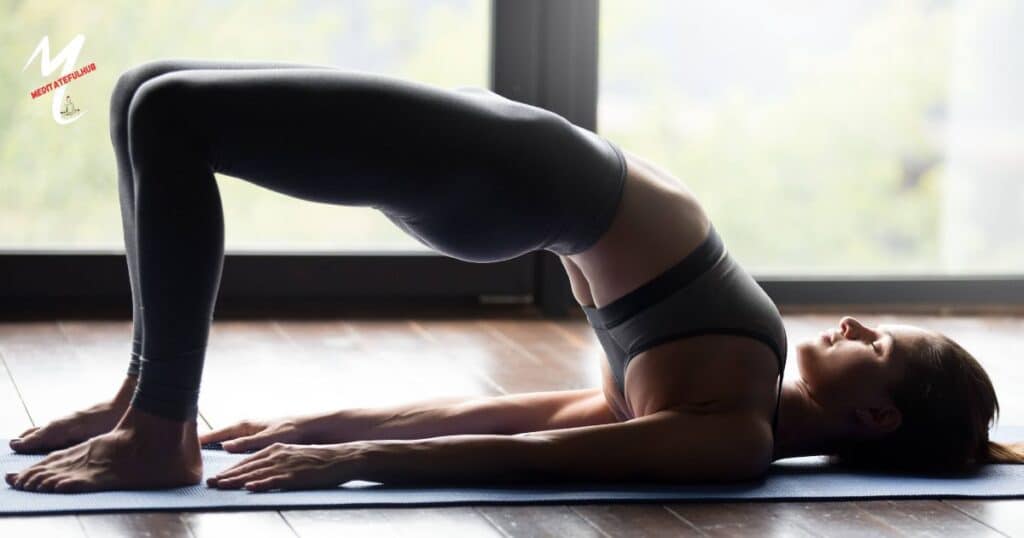
Certainly I’ll provide a simple table with basic information about the arched back posture
| Aspect | Description |
| Posture Name | Arched Back |
| Description | Involves arching the spine backward, creating a gentle curve in the lower back. |
| Purpose | Increases flexibility in the spine, stretches abdominal muscles, and can be used in certain yoga poses. |
| Benefits | – Improves spinal flexibility<br> – Stretches and strengthens back muscles<br> – Encourages good posture by opening the chest<br> – Can alleviate tension in the lower back. |
| Cautions | – Not recommended for individuals with certain back issues<br> – Should be done with awareness to avoid excessive strain on the lower back. |
| Common Uses | Yoga poses such as Cobra Pose (Bhujangasana) and Camel Pose (Ustrasana) often involve an arched back.<br> Also used in dance and certain stretching routines. |
Remember before attempting any new posture it’s essential to consult with a fitness or healthcare professional especially if you have pre-existing conditions or concerns about your physical health.
Child’s Pose (or Balasana)
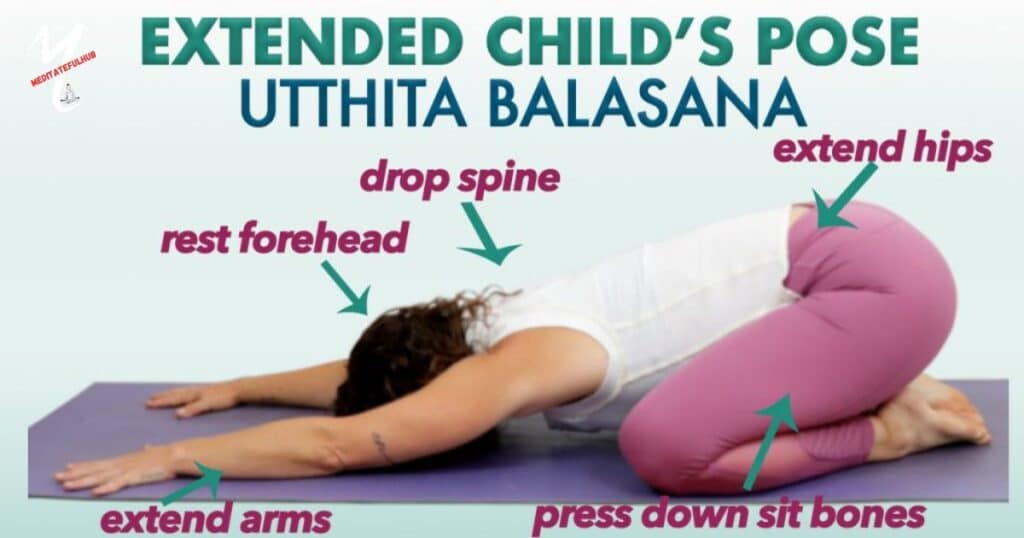
Here’s the paragraph incorporating the information about Child’s Pose (Balasana) and the use of a meditation cushion:
Child’s Pose (Balasana) is a soothing yoga posture where the practitioner rests on their heels extends their arms forward and gently lowers their chest towards the thighs creating a subtle arch in the spine. This restful pose is known for promoting relaxation stretching the back hips and thighs and providing a grounding sensation.
To enhance the comfort during meditation sessions in this pose many practitioners use a meditation cushion. Placing a meditation cushion under the hips adds extra support making it more comfortable for extended meditation or moments of reflection. The cushion helps ease any discomfort and allows for a more relaxed and focused meditation experience making Child’s Pose a versatile and restorative addition to one’s practice.
The Lotus (Padmasana) position
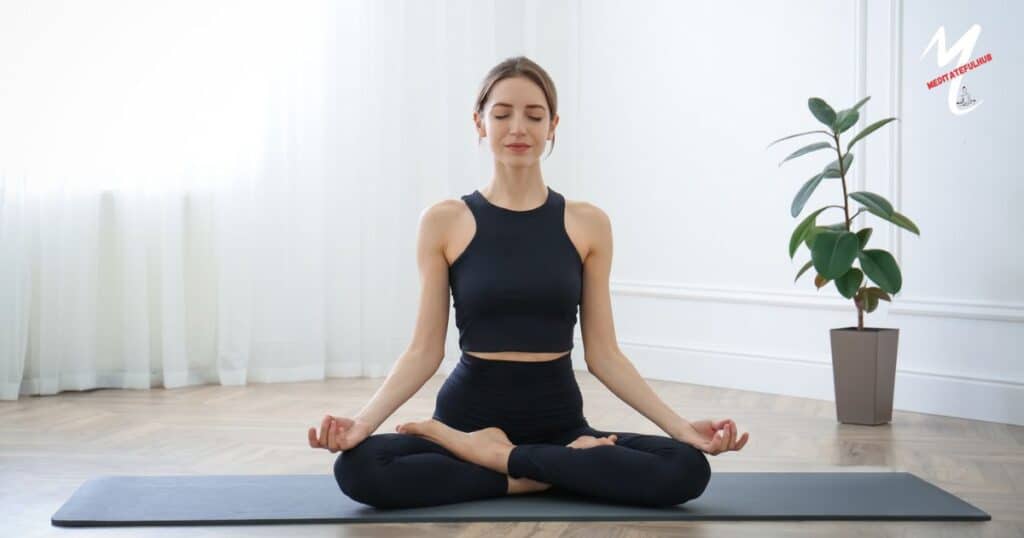
The Lotus position or Padmasana is a classic yoga pose that involves sitting with the legs crossed and the feet resting on the opposite thighs. This meditative posture is revered for promoting groundedness and concentration during meditation.
While achieving the full Lotus position might be challenging for some due to flexibility constraints using a meditation cushion under the hips can provide valuable support. A meditation cushion helps lift the hips and reduce strain making Padmasana more accessible and comfortable.
This prop is particularly beneficial for individuals who find it challenging to sit comfortably on the floor for an extended period. Integrating a meditation cushion into the Lotus position not only enhances physical comfort but also encourages a tranquil and focused mindset during meditation practices.
The Full Lotus Position
The Full Lotus Position or Padmasana involves crossing the legs with each foot resting on the opposite thigh promoting an upright posture during meditation.
Enhance comfort and support by using a meditation cushion under the hips reducing strain and allowing for a more relaxed meditation experience. This combination of posture and cushion facilitates a focused and serene meditation session.
The Half-Lotus Position
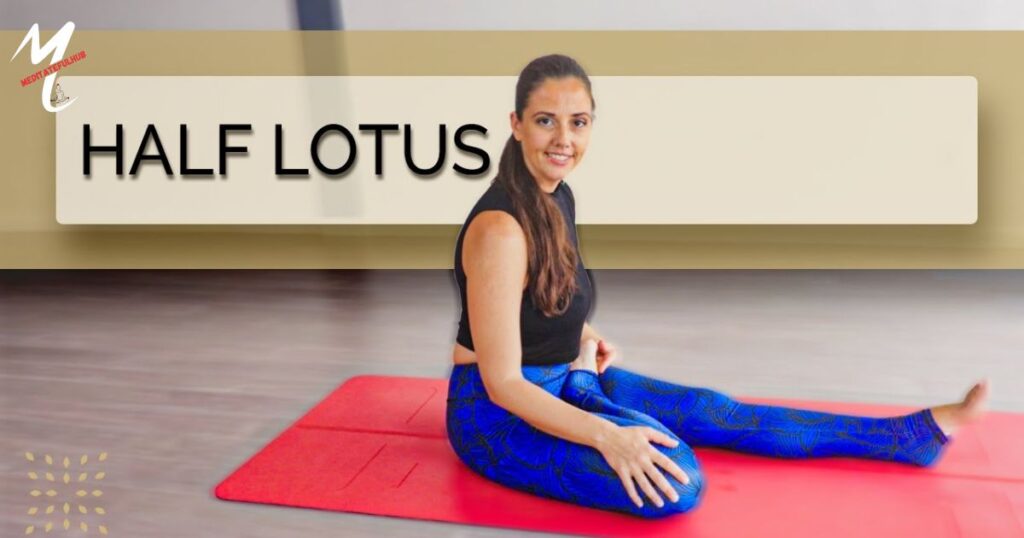
The Half-Lotus Position is a seated meditation posture where one foot rests on the opposite thigh while the other foot is positioned beneath the opposite knee.
This position provides a stable base for meditation, promoting an upright spine. For added comfort individuals may use a meditation cushion under the hips to reduce pressure and enhance the meditation experience.
The Quarter-Lotus Position
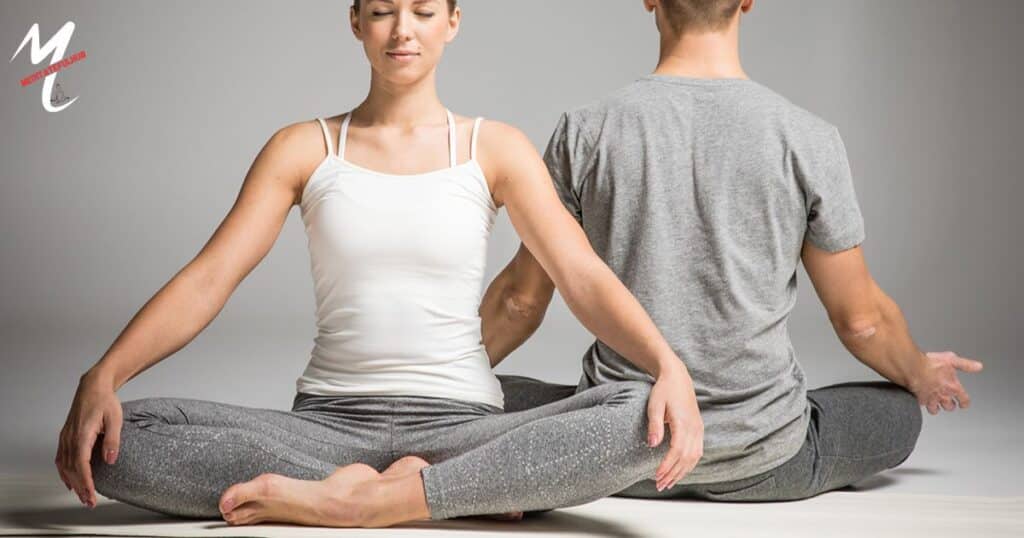
In the Quarter-Lotus Position one foot is placed on the opposite calf while sitting in a cross-legged posture. This variation offers a more accessible option for those with less flexibility.
To enhance comfort during meditation using a meditation cushion can provide support under the hips allowing for a relaxed and focused meditation experience.
A Few Tips About the Lotus Meditation Poses
- Begin with Comfortable Seating: Start by sitting in a comfortable position on the floor or a meditation cushion. Ensure your spine is straight promoting good posture for meditation.
- Basic Lotus Position: If you’re a beginner start with the Half-Lotus Position. Cross one foot over the opposite thigh keeping the other foot beneath the opposite knee. This offers a stable foundation without excessive strain.
- Gradual Progression: As flexibility improves, you can transition to the Full Lotus Position. Both feet rest on the opposite thighs. Be patient and avoid forcing your body into the pose progress at your own pace.
- Mind Your Knees: Protect your knees by ensuring they comfortably touch the floor. Using a cushion under your knees or sitting on a cushion can alleviate pressure and discomfort.
- Straighten Your Spine: Regardless of the Lotus variation maintain a straight spine. Engage your core muscles gently to support an upright posture aiding concentration and energy flow.
- Hand Placement: Rest your hands on your knees or in a mudra (hand gesture) of your choice. This enhances the meditative experience and helps focus your energy.
- Use a Meditation Cushion: Whether in Half-Lotus or Full Lotus a meditation cushion under your hips provides elevation and support reducing strain on the lower back and enhancing comfort during meditation.
- Breathe Mindfully: Once in your chosen Lotus pose focus on your breath. Inhale and exhale deeply cultivating mindfulness and a sense of tranquility.
- Listen to Your Body: If you experience pain or discomfort adjust your posture or switch to a more comfortable position. Meditation should be a positive experience not a source of physical strain.
- Consistent Practice: Regular practice will gradually increase flexibility and comfort in Lotus poses. Be persistent and over time you may find these meditation postures become more natural and enjoyable.
The easy pose (Sukhasana)
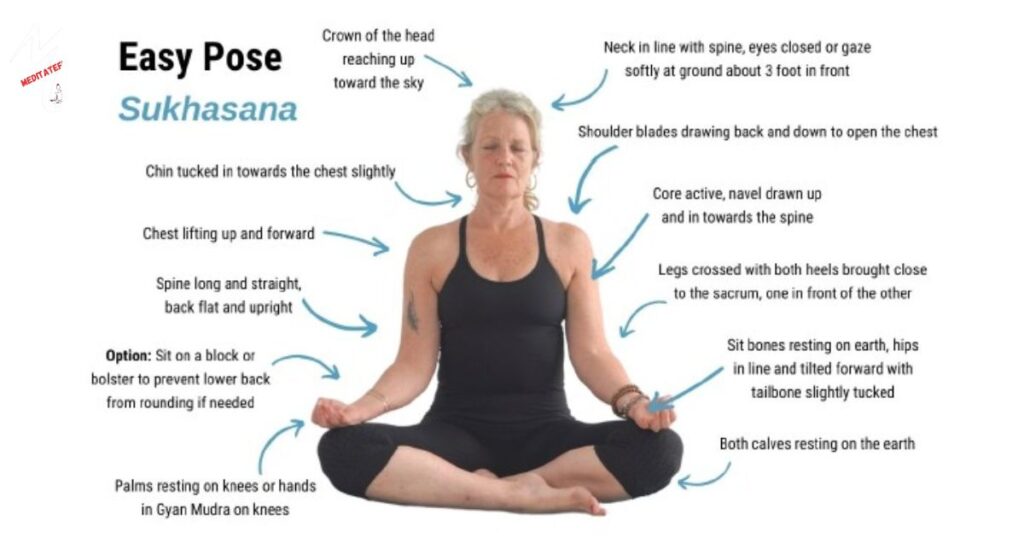
The Easy Pose or Sukhasana serves as a welcoming introduction to meditation offering a comfortable and accessible posture for practitioners of various levels. Begin by sitting cross-legged on the floor or a cushion ensuring a relaxed and aligned posture.
Elevate your pelvis with a cushion if needed, allowing for a natural curve in the lower back. Align your spine relax your facial muscles and breathe mindfully. This uncomplicated pose provides a foundation for a peaceful meditation experience and modifications such as using a cushion under the hips can enhance comfort for an extended and undisturbed practice.
Sukhasana invites practitioners to embrace the simplicity of the present moment, making it an ideal starting point for those exploring the benefits of meditation.
The Burmese position
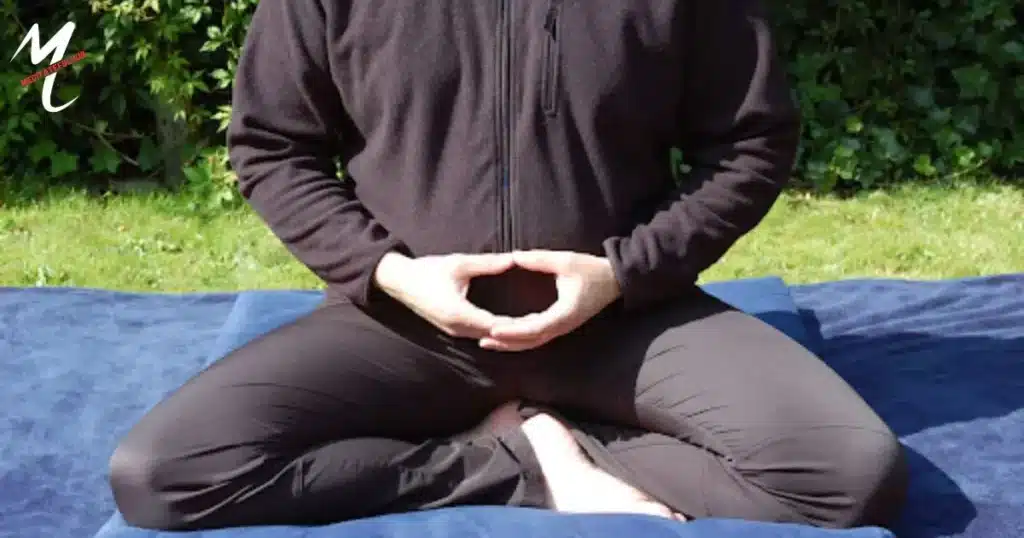
The Burmese meditation position involves sitting cross-legged on the floor using a cushion under the buttocks for comfort. This posture helps maintain a natural spinal alignment reducing pain during meditation. Hands can rest on the knees or in the lap allowing for a relaxed yet upright posture.
Suitable for both beginners and experienced meditators the simplicity of the Burmese position fosters a tranquil and focused state of mindfulness. By providing stability and comfort it encourages a serene meditation experience making it a popular choice in the meditation community.
The Hero pose (Virasana)
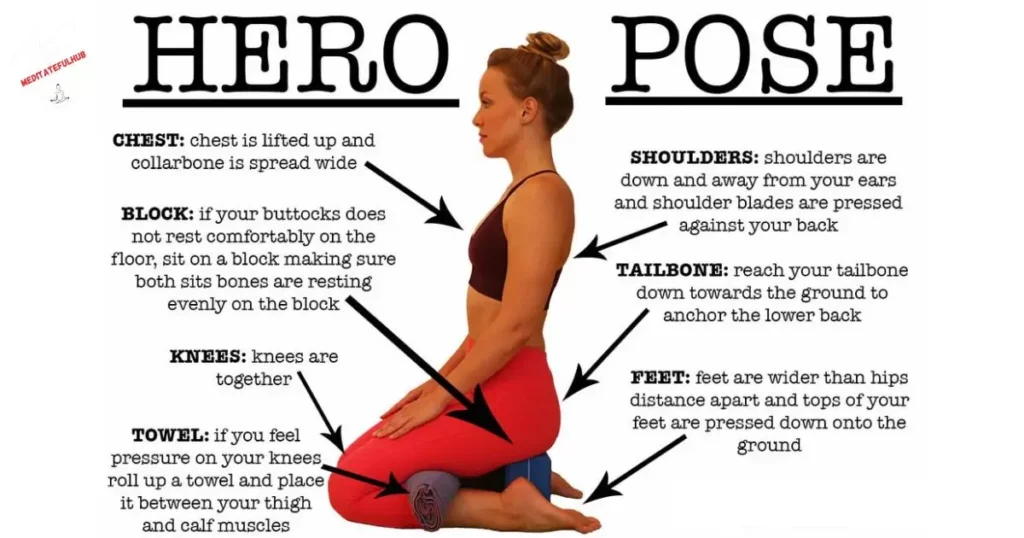
The Hero pose or Virasana in yoga is a seated posture that involves kneeling on the mat with the knees together and sitting back on the heels. Keep the hands resting on the thighs or in the lap. This pose is beneficial for improving posture stretching the thighs and strengthening the arches of the feet.
It is also commonly used as a preparatory pose for more advanced seated postures and meditation. The Hero pose is accessible for most practitioners and provides a grounding and calming effect making it a great choice for meditation or moments of reflection.
The Thunderbolt pose (Vajrasana)

The Thunderbolt pose or Vajrasana in yoga is a seated posture where you kneel on the mat lowering your body onto your heels with your big toes touching. Keep the spine straight and place your hands on your thighs or in your lap. This pose is known for aiding digestion relieving sciatic pain and promoting focus during meditation.
Vajrasana is a simple yet effective posture suitable for practitioners of all levels and it can be practiced after meals to enhance digestion. Regular practice of the Thunderbolt pose helps cultivate a sense of stability making it a valuable addition to both yoga and meditation routines.
The bound angle pose (Baddha Konasana)
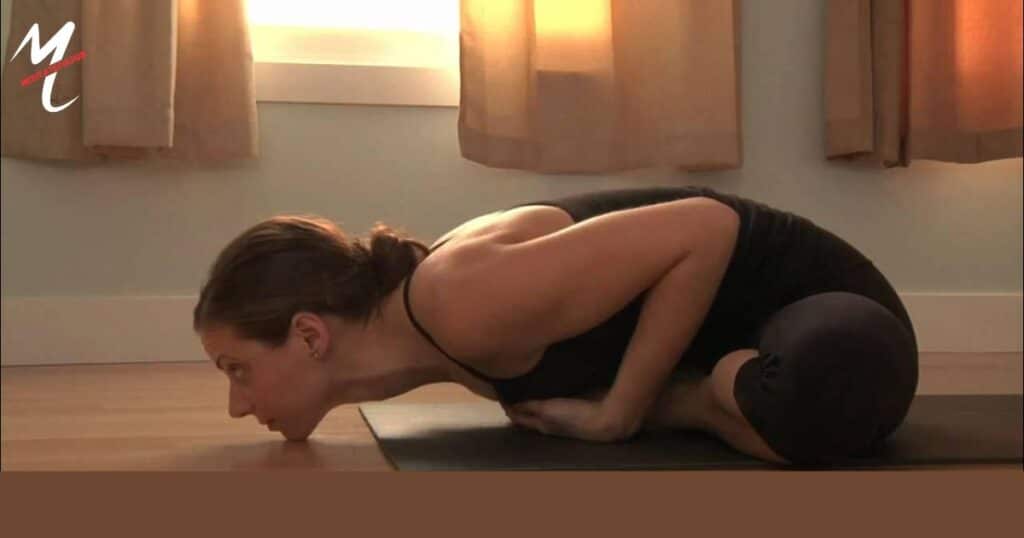
The bound-angle pose or Baddha Konasana in yoga involves sitting on the floor with the soles of the feet together and knees bent outward. Hold the feet with your hands and sit up tall maintaining a straight spine. This pose is excellent for opening the hips stretching the inner thighs and improving flexibility.
Baddha Konasana is often used in meditation and pranayama practices to enhance focus and relaxation. It is accessible to practitioners of various levels and is particularly beneficial for those looking to release tension in the groin and hip area. The bound-angle pose encourages a sense of grounding and can be a valuable addition to a well-rounded yoga routine.
Zen Sitting Posture
The Zen sitting posture is a fundamental position used in Zen meditation (zazen). To practice this posture sit on a cushion or mat with your legs crossed in a comfortable but stable position. Keep your spine straight, shoulders relaxed and hands placed in a mudra on your lap.
The common mudra is to place your right hand on your left with the thumbs lightly touching forming an oval. Rest the hands against your body creating a stable triangle with your body.
This Zen sitting posture is characterized by a grounded and alert stance promoting mindfulness and focus during meditation. It is essential to find a position that balances both stability and comfort to support a prolonged period of meditation practice.
Zen Standing Posture
In Zen practice the standing posture is often used as a complement to seated meditation. To assume a Zen standing posture stand with your feet shoulder-width apart. Allow your arms to hang naturally by your sides with your hands forming loose fists and keep your shoulders relaxed.
This standing posture in Zen emphasizes a sense of alertness and grounded awareness. It can be employed as a transition between periods of seated meditation or as a standalone practice.
The focus is on cultivating mindfulness and presence in an upright stance promoting balance and stability both physically and mentally. Practitioners often incorporate mindful breathing and attention to the present moment while maintaining the Zen standing posture.
Monk Sitting Position
The monk sitting position often associated with meditation practices in various traditions typically involves sitting on the floor or a cushion. The specifics can vary but a common posture is a cross-legged position like the lotus or half-lotus pose to promote stability and an upright spine.
The hands may rest on the knees or in a specific mudra such as the cosmic mudra where the hands form a circle with the thumbs lightly touching.
The monk sitting position emphasizes a balance of alertness and relaxation supporting extended periods of meditation. It is characterized by a straight spine relaxed shoulders and a calm demeanor. This posture is not limited to monks and is adopted by practitioners of various meditation traditions seeking a grounded and focused state of mindfulness.
Meditating while seated on a chair
Meditating while seated on a chair is a straightforward practice that brings tranquility to your daily routine. Begin by finding a quiet spot where you won’t be disturbed. Sit comfortably ensuring your back is straight and close your eyes gently. Position your feet flat on the ground fostering a sense of stability and let your hands rest on your knees or in your lap.
Take a moment to inhale deeply through your nose feeling your lungs expand and then exhale slowly through your mouth releasing any tension. As you continue maintain your focus on the rhythmic flow of your breath. If your mind starts to wander gently guide your attention back to your breath.
Enjoy this brief yet rejuvenating practice taking a few moments of stillness before opening your eyes. Incorporating this simple seated meditation into your daily routine can contribute to a calmer and more centered state of mind.
The Importance of Maintaining Proper Back Alignment
Maintaining proper back alignment is vital for overall health. It supports the body’s structure reducing the risk of chronic pain and musculoskeletal issues. Proper alignment distributes weight evenly preventing strain on specific joints.
It fosters healthy posture, minimizing the risk of conditions like kyphosis or lordosis. A well-aligned spine supports the optimal function of the nervous system. Incorporating regular exercise and mindful posture practices contributes to a foundation of back health promoting overall physical well-being.
FAQ’s
How do meditation cushions work?
Meditation cushions provide support and comfort by elevating your hips aligning your spine and reducing strain during meditation. They help maintain a relaxed and stable posture.
Do I really need a meditation cushion?
It’s not mandatory, but a meditation cushion can enhance your comfort and focus during meditation by promoting proper alignment and reducing discomfort. It’s a personal preference.
Is it worth buying a meditation cushion?
If you meditate regularly, a cushion can be worth it for improved comfort and support. Consider your comfort level and how much you value a dedicated meditation space.
What is inside meditation cushion?
Meditation cushions typically contain materials like buckwheat hulls kapok or cotton batting. These materials provide a supportive yet flexible base for comfortable sitting.
What is a Buddhist meditation cushion called?
A meditation cushion commonly used in Buddhist practice is called a “zafu.” It is a round cushion-like pillow designed to support proper meditation posture.
Conclusion
Unlock the transformative power of proper seating on a meditation cushion with the question How To Sit On A Meditation Cushion? Achieving a comfortable and stable posture is fundamental to deepening your meditation practice. Begin by finding a quiet and peaceful space then choose a cushion that supports your spine and allows your knees to rest comfortably on the floor.
Gently cross your legs and place your hands on your lap or knees maintaining a straight and relaxed back. This alignment promotes better focus and helps you stay present during meditation fostering a deeper sense of mindfulness.
As you settle into your seated position let go of tension in your body and take slow deep breaths. Feel the connection between your body and the cushion grounding yourself in the present moment. By incorporating these simple steps into your meditation and create a conducive environment for inner peace and self-discovery.

George, an esteemed author with 8 years of experience in meditation, imparts transformative knowledge on meditatefulhub.com. His writings resonate globally, guiding individuals on a profound journey of self-discovery and inner peace.





